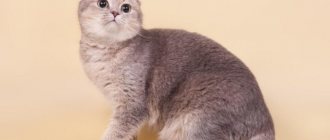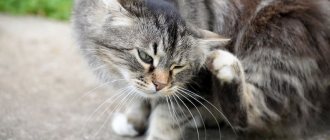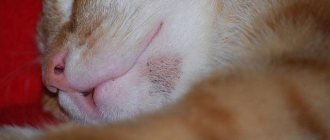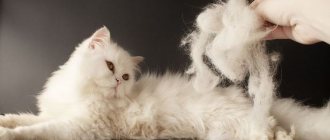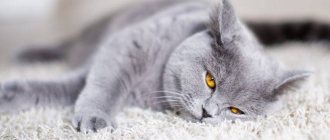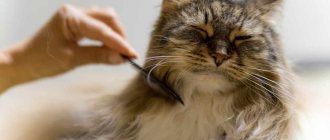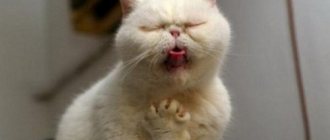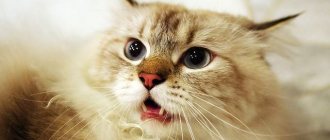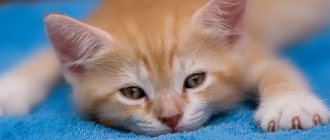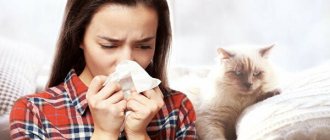Shedding in a cat is one of the most important problems that a person who does not know the characteristics of the cat’s body, character, cat breed, etc. may encounter.
You don't always need to sound the alarm when you notice that your cat has begun to shed heavily.
In this article we will consider such important issues as:
- What is the molting process?
- Why does a cat shed? (causes)
- Kittens' first molt
- Shedding periods in adult cats
- What to do if your cat sheds a lot? (medicines and grooming)
- Anti-shedding food
- What cat breeds don't shed?
- How we deal with our cat's shedding (advice from experienced people)
What periods are considered normal for molting in terms of time of year and duration?
Seasonal coat change is a natural phenomenon that should not bother owners.
Cats shed their hair from time to time. The first hair change is called juvenile. A teenager changes his child's coat to an adult's one at six months of age, sometimes a little earlier or later.
Mature cats shed twice a year: in spring and autumn. This is how animals protect themselves from summer heat and winter frosts. This molting is called seasonal, or physiological.
The hair change process takes up to nine weeks. Shedding usually does not cause problems in pets of short-haired breeds. Long-haired cats need help from their owners. If you do not comb out the hair that falls out, tangles form, within which ideal conditions are created for the reproduction of ectoparasites.
What to do if your cat sheds a lot? (medicines and grooming)
To reduce the negative effect of cat shedding, it can be “optimized.” Thus, there are a number of special medications that not only stop the process of heavy shedding, but also stimulate the formation of healthy hair in cats.
Neo
Omega
has proven itself well that promote the growth of healthy hair, containing Omega-3 substances and antioxidants.
In addition, there is a drug
Shed- Pro
, which stops intense shedding and removes the fur that has gotten there from the cat’s stomach.
Omegaderm
eliminates skin itching, restores the animal's skin and maintains the coat in proper condition.
Alloderm
Spot On
are drops for external use that quickly restore damaged epidermis and also significantly speed up the process of shedding.
Grooming (haircut)
Cat grooming is one of the effective ways to alleviate the possible consequences of shedding. Firstly, you will not need to constantly comb your cat and remove clumps of its fallen fur, and, secondly, you will prevent the cat from swallowing its own hair when licking, and thereby reduce the risk of obstruction of its intestinal tract.
Causes of severe shedding
Long-term intense hair loss is called pathological shedding.
It occurs for the following reasons:
- congenital anomalies;
- unbalanced diet;
- frequent bathing;
- stress;
- allergy;
- drug dermatitis;
- hormonal disorders;
- infectious diseases;
- oncology.
Congenital pathologies
With a genetic abnormality called hypotrichosis, the kitten's hair begins to fall out rapidly. By eighteen weeks the pet is completely hairless and remains that way for the rest of its life.
Also, a kitten may have a genetic predisposition to seborrhea or adenitis - hypersecretion of the sebaceous glands. An additional sign of the presence of one of these diseases is an unpleasant odor from your pet’s skin.
Unbalanced diet
Each cat has different nutritional needs. Some pets are not suitable for ready-made food, while others are not suitable for natural food. First, the fur stops shining, then it becomes disheveled and begins to fall out.
Be sure to read:
A cat's hair is falling out: reasons, what to do during shedding, treatment of baldness, approved medications
Sometimes the cause of deficiency is a changed physiological state.
A lactating female requires a diet richer in healthy components. Nutrients are primarily used to maintain vital functions and synthesize milk. The hair does not receive enough of it and therefore dies.
Not only a deficiency, but also an excess of nutrients has an adverse effect. Thoughtless use of vitamin supplements leads to poisoning. The body gets rid of toxic metabolites through diarrhea, vomiting, increased urination and shedding hair.
Frequent bathing
Cats can, but don't like to swim. They don't need bathing. Often overly caring housewives regularly wash their pussy. The shampoo degreases the hairs, they lose their protective layer, become brittle, and fall out.
Stress
A change of environment, a long journey, fear, jealousy, or a sudden change in diet can cause an inadequate reaction. The cat develops baldness in certain areas, sometimes half of the body.
Allergy
Hair loss is a side effect of medication.
Your pet may have an allergic reaction to:
- feed components, such as chicken or cereal proteins;
- odors, perfumes, tobacco smoke, pollen, fungal spores - atopic dermatitis;
- household chemicals, accessories, flea collars - contact dermatitis.
Additional symptoms of allergies are rashes, crusts and ulcers.
Drug dermatitis
Hair loss is a side effect of medication use. The course of treatment is interrupted and the drug is replaced.
Hormonal disorders
The main cause of hormonal disorders is diseases of the endocrine glands or regular use of contraceptives: Contrasex, Anti-meow, etc.
Contagious diseases
Hair loss in most cases is accompanied by a violation of the integrity of the skin.
It is provoked by the following diseases:
- lichen - a fungal infection of the skin;
- flea dermatitis;
- notoedrosis, demodicosis - lesions by intradermal mites;
- helminthiasis - infection by parasites.
Oncology
Cancer affects all life support systems, including hair follicles. The onset of tumor formation usually coincides with the aging of the cat.
Hair loss is a serious symptom
Seasonal shedding in cats lasts from two to three weeks to one and a half months; the age-related change of coat in kittens can last for six months. In theory, anything outside these parameters should be considered an abnormality. But there is a nuance: as we said, after moving into houses, our smaller brothers can shed all year round, while remaining completely healthy.
Domestic cats can shed all year round
Yet hair loss in animals is often a symptom of a disease or other health disorder, and domestic cats are no exception. Thus, a paradoxical situation arises: the same external manifestations can be either a kind of “payment for shelter” or an alarm bell. In one case, nothing needs to be done, moreover, an attempt to treat the animal can cause harm to it, and in the other, the pet, on the contrary, needs qualified help. The problem is so difficult that even an experienced veterinarian is not always able to solve it. But a responsible animal owner simply must do this. So the cat is shedding. Most likely, everything is fine with her if:
- the skin visible between the hairs retains a natural and uniform color;
- the fur does not fall out in clumps, leaving bare areas of skin (bald spots can appear behind the ears, above the eyes, on the stomach, thighs, and the inner surface of the paws);
- the pet’s behavior has not changed, the cat looks healthy, eats well, digestion is not upset;
- urine and feces have normal color and odor;
- the animal's nose is moist, its eyes are shiny;
- there is no frankly unpleasant odor from the mouth;
- Body temperature, if you can measure it, is normal (in cats it is between 38.0 and 39.0).
In a word, you need to understand a simple thing. Hair loss is almost never the only symptom of a particular disease: as a rule, there are other signs. Finding them or making sure that they are absent is the main task of the owner. Let's look at some of the most common causes of pathological hair loss in cats.
Hormonal disbalance
When experts strongly recommend sterilizing domestic animals of both sexes (with the exception of those specifically used for breeding), they know what they are talking about.
It has been observed that sterilized cats live an average of 15–20 years. For comparison, the average lifespan of a domestic cat is 10–12 years; outdoor cats rarely live past 5 years of age. And if the difference between a pet and an animal forced to fight for survival can be explained by the quality of life (in civilized countries people also live longer than in backward ones), then the obvious advantage of sterilized animals over their no less “caressed” brothers is explained by only one thing - the absence hormonal shocks.
In favor of sterilization, it should also be said that cats, like the vast majority of animals, do not have such a thing as orgasm. Mating and childbearing, contrary to the opinion of some “humanists,” are not beneficial to the cat’s health; this is just a natural need to preserve the species, which in the case of pets is perfectly solved through targeted breeding.
If you do not agree with the position accepted as the basis throughout the civilized world, at least take the trouble to ensure your animal’s full realization of sexual instincts, but under no circumstances do you stuff it with hormonal drugs that suppress sexual desire, and do not endure heart-rending screams while clenching your teeth unfortunate beast.
This is inhumane and very dangerous for the cat’s health.
Estrus causes a lot of inconvenience for a cat and its owner.
Severe hair loss is often caused by hormonal imbalance, and the latter, in turn, is inevitable when taking various “anti-sex medications.” The same reason, by the way, explains the increased shedding in cats after estrus, during pregnancy and after childbirth: hormones go crazy - just like in humans.
Stress
We come to another problem that can cause hair loss. This is an emotional shock.
Usually a cat knows how to stand up for itself
But there are factors to which even these proud and independent creatures react very painfully. These include, in particular:
- moving (the well-known formula that a dog is attached to its owner, and a cat is attached to the house, is only partly true, but there is certainly some truth in it);
- transportation, especially in tight carrying;
- painful medical procedures associated with anesthesia, fixation (tying up) and other violations of “personal integrity”;
- the appearance of another animal in the house, especially if it is perceived as a source of danger or a “competitor”;
- loneliness, especially if for the first time the animal is left alone in an empty room for a long period of time;
- a sharp change in attitude towards oneself on the part of the owner;
- the introduction of new rules and restrictions that did not exist before (for example, a cat got used to sleeping with its owner, and at some point they stopped allowing it to do so).
The cause of hair loss may be longing for its owner.
In a word, if a cat begins to lose a large amount of hair, think about whether something happened that provoked strong feelings in the animal.
Allergy
Allergies in cats are usually accompanied not just by hair loss, but by the formation of bald patches (so-called alopecia).
But the opposite rule does not work: allergies are not the most likely cause of baldness in individual areas of the skin, and their localization in this case will not clarify anything.
One of the causes of receding hairline is allergies.
The only correct course of action is to analyze whether there have been any changes in the diet, and if there have been, exclude the probable allergen, and then continue observation.
Poor nutrition and dysbiosis
A cat's diet must be balanced; food from our table cannot replace it.
High-quality cat food contains everything necessary for the health of the animal. Adherents of natural food need to put in a lot more effort to make their pet's coat shiny and glossy.
Sometimes the cause of hair loss is dysbiosis, which is not caused by nutritional problems, but, for example, by recent antibiotic treatment. In this case, shedding is usually accompanied by other characteristic symptoms, primarily intestinal dysfunction.
Old age
As we age, various diseases appear and worsen, and the body begins to work like a poorly regulated machine. The same thing happens with cats.
In an older animal, the fur coat loses its thickness and silkiness, becomes tangled and falls out, sometimes forming quite distinct bald spots.
This is a natural and, unfortunately, irreversible process.
In old age, the animal’s fur no longer looks thick and silky.
Diseases in cats
Increased hair loss can be a sign of a disease, either skin, caused by parasites or fungal infections, or internal. The first category of diseases includes:
- ringworm (fungal infection, pathogens - dermatophytes);
- demodicosis (caused by subcutaneous mites);
- dermatitis (can be caused by bacteria, fungi and even flea bites);
- scabies (caused by the Notoedris cati mite);
- eczema (can be caused by various reasons).
All these diseases have a very clear clinical picture, the lesions are clearly visible, and if you consult a specialist in a timely manner, diagnosis and treatment do not cause problems.
Ringworm is an infectious skin disease of a fungal nature.
The situation is more complicated with systemic internal diseases, which at a certain stage begin to acquire external manifestations, affecting, in particular, the quality of wool. In fact, this symptom can be caused by literally anything: from endocrine system disorders, including diabetes, to neoplasms.
In such cases, hair loss is a secondary symptom; therefore, there is no point in fighting it: you need to look for the cause of the disease and treat it.
Ways to reduce shedding
To reduce the intensity of hair loss, the root cause is eliminated. Cats suffering from seborrhea and adenitis are treated during exacerbations with external means - aerosols or ointments, which are prescribed by a veterinarian.
Be sure to read:
Why does a cat shake its ears and head constantly, causes of itching, how to help and what to do
Hair loss from a lack of nutritional components is observed when feeding natural food, ready-made economy-class food. Some foods are not suitable for animals. Your veterinarian can advise you on which foods or supplements to use and which to avoid.
Sometimes hair loss stops if you stop bathing your pet frequently. When stressed, the fur grows back when the animal calms down. To do this, you need to play with your pet, pay attention to it, and pet it. They also use sedatives: Kot Bayun, Stop-stress, Feliway.
To treat infectious diseases, hormonal disorders, oncology and side effects of drugs, they seek veterinary help.
Long-haired pets are periodically combed.
How to clean wool from upholstered furniture
Most often, wool remains on sofas, armchairs and other upholstered furniture. Animals can leave entire balls of wool on these items. To clean upholstered furniture, first go over the surface with a damp cloth, and then vacuum the upholstery. Use a high-quality modern aqua filter, and then removing hair and dust in a short time will not be difficult.
There is an effective method for cleaning a sofa and armchairs, which reliably removes wool, lint and dust, kills bacteria and dangerous microorganisms. To do this, place a damp sheet on the furniture and knock out the objects.
Dust and hairs will come out from the depths of the products and settle on the sheet. Repeat the procedure once or twice and then vacuum the upholstery. Finally, you can steam the furniture with an iron.
You can remove fur with a stiff rubber brush, rubber gloves or a rubber roller. Rubber easily attracts fluff, as it has good static properties. Another available method is to remove dog or cat hair using tape.
To do this, glue a wide strip of cattle onto the upholstery of a chair or sofa and tear it off, then the hair will remain on the tape. This procedure takes a long time, but reliably removes hair from soft products and fabrics.
How to relieve a cat's condition
Hypotrichosis is incurable. The animal will constantly freeze. Therefore, it is necessary to maintain an optimal air temperature in the apartment - 22-24 °C. If the owners decide to walk the cat in cool weather, they will have to dress it.
Long-haired pets are periodically combed.
In long-haired pets, in addition to excessive shedding, intestinal blockage may occur with trichobezoars - stones formed from a mixture of hairs swallowed while licking and the contents of the alimentary tract.
If the cat owner does not use special super-premium food, you will have to periodically give Malt paste, which prevents hair from clumping.
To speed up molting, special feed additives are used:
- Laveta Super from Beafar;
- Sherstevit;
- Gimpet.
Products based on brewer's or feed yeast reduce the duration of shedding. Caring for a shedding pet involves frequently combing out lost hair.
In advanced situations, the crumpled wool is removed using tangle cutters. If the cause of hair loss is a contagious disease, you must follow the instructions of your veterinarian.
Proper cat hair care
Regular proper care of a cat's coat facilitates seasonal shedding and improves the condition of the coat . Care depends on the length of the cat's fur.
Short-haired cats are combed 1-2 times a week using a fine-toothed comb, a furminator to remove dead undercoat, and a rubber brush to remove combed hair and massage the skin, which improves blood supply to the hair follicles and strengthens the coat. You can use suede to add shine to the wool.
Long-haired cats are brushed daily for 15–20 minutes. To care for a long-haired cat you need:
- ridges: rare and frequent;
- a furminator with long teeth for removing undercoat or a slicker;
- metal brush;
- a soft brush to remove loose hair or a rubber brush.
The fur is combed from the tail to the head - this way you can get rid of more hairs. First use a comb with rare teeth, and then with frequent ones. After combing against the growth of the fur, the direction is changed. To remove undercoat, use a furminator or slicker - no more than once a week. At the end of combing, the separated wool is collected using a soft brush; you can use a rubber mitten brush. Some owners prefer to supplement grooming by stroking the cat with a damp hand to collect any remaining loose hair.
Constant proper grooming makes shedding easier
To make it easier to comb the coat, you can use a special powder. It is better not to use natural bristle brushes as they are not hygienic enough.
Cats are washed only when dirty or before shows. Frequent bathing can have a negative impact on their coat. When washing, use only zoo shampoos.
Video: how to brush a cat while shedding
Actions in case of pathological condition
First of all, pay attention to the well-being of the pet. If the cat feels normal, it is necessary to switch to super-premium hypoallergenic food.
The use of vitamin supplements along with natural food or economy-class food is dangerous.
An overdose will only increase shedding. If the cat feels unwell or changing food does not help, seek qualified help.
Be sure to read:
Bald patches in a cat near the ears and above the eyes: reasons, what to do, how to distinguish normality from pathology
Ten ways to remove cat hair from clothes
- Wet your hands with water and wipe the clothes from top to bottom, the hair will roll up and remain on your hands;
- Use a clothes brush or sticky rollers. The brush must first be moistened in water and then walked over the surface of the things;
- If you use a sticky roller or roller, choose reusable products with a gel coating. Standard models become dirty in a short time and lose their sticky properties, after which they are no longer suitable for use. The gel roller can be washed with soap and water, dried and used again;
- Scotch tape will also help with clothes. Glue the adhesive tape to the material and carefully tear it off, it will collect lint and small debris;
- Clean clothes using a vacuum cleaner with a turbo brush. First, hang the item on hangers and steam the material with a steam generator, hand steamer or an iron with a vertical steamer function. Then go over the surface with a vacuum cleaner;
- To clean, take a regular soft sponge for washing dishes, wet it and squeeze it out, run the rough side over the surface of the material from top to bottom;
- Nylon or nylon removes hair well. To do this, you can take nylon or nylon tights or socks and walk over the clothes;
- To prevent fur from sticking to things, store clothes in special cases or be sure to put them in a closet away from pets. How to properly and practically lay out clothes on shelves and in a wardrobe, read the article “How to properly store things in a closet”;
- When drying clothes in the washing machine, wrap an antistatic cloth in a cloth. Then the hairs will not stick to things;
- When rinsing, add fabric softener to the water. You can also use a solution of vinegar and baking soda in a ratio of 6:1, or table salt or citric acid in the amount of one teaspoon per ten liters of water. This rinsing prevents wool from sticking and electrifying clothes, softens and refreshes the fabric, and completely removes any remaining soap or washing powder from items.
Vitamins for cats
Cat owners have a choice: give imported complete food of premium class and higher or use natural food. In the first case, vitamins are not needed. They are included in the finished dry food in the required quantities and optimal ratio.
If the owner uses an unbalanced diet, the pet may develop problems with its coat. The problem is eliminated with the help of complex vitamin and mineral supplements.
Cat lovers prefer to use the following drugs:
- Felvit Multi;
- Kitty's +Taurine-Biotine;
- Gimpet Katzentabs;
- Laveta Super;
- Kitty's +Taurine-Biotine/Proteine/Cheese (vitamin mixture for cats);
- vitamins Doctor ZOO.
How to reduce cat shedding
In order to properly treat excessive shedding, it is necessary to find out what caused it. Therefore, the first thing the owner should do is contact a veterinary clinic. Do not treat your cat at your own discretion: incorrect actions will aggravate the condition. The veterinarian will find out why the cat sheds, prescribe appropriate treatment, tell you what drug to use for infection, seborrhea, parasites, and whether the cat’s diet needs to be changed.
In the vast majority of cases, a cat sheds due to poor-quality food, so the veterinarian gives advice on diet and recommends vitamins to strengthen the coat.
Anti-shedding food
With an unbalanced diet, after losing weight, a deterioration in the condition of the coat follows. The owner has two options on what to do to prevent the cat from shedding any more:
- buy high-quality premium or holistic food that contains a full range of vitamins and nutrients;
- diversify your natural diet, include dietary supplements and vitamin preparations.
The best brands of complete food are Acana, Royal Canin, Applaws, Brit.
Do not feed your cat only canned food, use it as a treat. This type of food does not contain the required amount of substances beneficial to the coat.
To make seasonal shedding easier, add chicken yolk and fish oil to your cat's diet. These products are valuable sources of minerals, vitamins, and fatty acids that have a general strengthening effect on the cat’s body, ensuring smooth and healthy fur.
Vitamins for cats
Buy vitamin preparations on the recommendation of a veterinarian, do not exceed the dosage so that your pet does not suffer from hypervitaminosis.
Which vitamins to buy depends on the purpose of use:
- for strength and health of the coat - group B, kelp, iodine;
- to prevent the cat from shedding excessively - Biofaktory Felvit Multi, Beaphar Laveta Super, Beaphar Kitty's + Taurine-Biotine, GimCat Katzentabs;
- to reduce the time during which a cat sheds, brewer's yeast.
Wet cleaning
How to deal with cat hair in an apartment if you don’t have a suitable vacuum cleaner or other vacuum device at hand? Daily cleaning.
There are quite a few practical ways to get rid of cat hair in an apartment. To clean parquet floors, use a damp mop. A cleaning agent for wood floors is diluted in a special container, the mop is dipped and the surface is washed. Like a magnet, the mop's damp base will pick up cat lint, leaving a clean, moist floor. Wet cleaning not only ensures fresh air in the area where pets live, but also prevents the hassle of cleaning up shedding hair.
A clean animal means a clean home
During periods of heavy shedding, owners are concerned about the problem of how to deal with cat hair in the apartment. With timely intervention, it will not be difficult for a careful owner to keep the cat clean.
First you need to clean your cat's fur. The animal is washed twice with shampoo and conditioner. Rinse with water at least twice to completely remove excess hair. Don’t forget about your pet’s health and cover its ears while bathing. Drops of water can harm a cat's ears.
Sources:
https://gafki.ru/koshki/kak-izbavitsa-ot-sersti.html https://kotikoshka.com/ukhod-za-koshkami/kak-izbavitsya-ot-shersti-koshki-v-kvartire-poleznye-rekomendatsii .html https://koshek.ru/kak-borotsya-s-vyipadayushhej-sherstyu-koshek-v-kvartire.html

